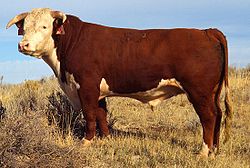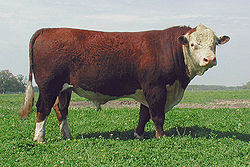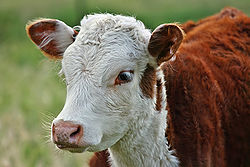- Hereford (cattle)
-


Grazing Hereford cattle Hereford cattle are a beef cattle breed, widely used both in intemperate areas and temperate areas, mainly for meat production.
Originally from Herefordshire, England, United Kingdom,[1][2] more than five million pedigree Hereford Cattle now exist in over 50 countries. The Hereford cattle export trade began from United Kingdom in 1817, starting in Kentucky, United States,[3] spreading across the United States and Canada through Mexico to the great beef-raising countries of South America. Today, Hereford cattle dominate the world scene from Australasia to the Russian steppes. Hereford Cattle can be found in Israel, Japan and throughout Continental Europe and Scandinavia.[4]
They are found in the temperate parts of Canada, United States and Russia as well as the temperate parts of Australia, the centre and east of Argentina, in Uruguay, and New Zealand, where they make up the largest proportion of registered cattle.[5] They originally found great popularity among ranchers of the American Southwest, testament to the hardiness of the breed; while originating in cool, moist Britain, they have proven to thrive in much harsher climates on nearly every continent.
The World Hereford Council[6] is based in the United Kingdom; the Secretary General, Mrs. Jan Wills, is from New Zealand. There are currently 17 member countries with 20 Hereford societies and 10 non-member countries with a total of eight societies.[7] The next World Hereford Council conference will be held in Calgary, Alberta, Canada, July 10–15, 2012.
The European Hereford organisation[8] is holding their 2010 conference in Scotland, 23rd to 28 June.[9]
Contents
History
Until the 18th century the cattle of the Herefordshire area were similar to other cattle of southern England, being wholly red with a white switch, similar to the modern North Devon and Sussex breeds. During the 18th century and early 19th century other cattle (mainly Shorthorns) were used to create a new type of draught and beef cattle which at first varied in colour, different herds ranging from yellow to grey and light brown, and with varying amounts of white. However, by the end of the 18th century the white face characteristic of the modern breed was well established, and the modern colour was stabilised during the 19th century.[10]
The Hereford is still to be seen in the Herefordshire countryside today[11] and features prominently at agricultural shows.[12][13][14] The first imports of Herefords to the United States were around 1816 by the politician Henry Clay, with larger importation of the breed beginning in the 1840s.[15][16]
Polled Hereford
The Polled Hereford is a hornless variant of the Hereford with the polled gene, a natural genetic mutation that was selected into a separate breed beginning in 1889.[17]
Iowa cattle rancher Warren Gammon capitalized on the idea of breeding Polled Hereford and started the Polled Hereford registry with eleven naturally polled cattle. Today, in the United States the American Polled Hereford and American Hereford breed has been combined under the same American Hereford Association name.[citation needed]
The Polled Hereford breed is bred for its deep fore-quarters, depth and muscling, docile temperament, fast growing calves, and good quality of beef.[citation needed] Hereford cattle are also known to be easy breeders and easy calvers.
Traditional Hereford
Many strains of Hereford have used other cattle breeds to import desired characteristics, and this has led to changes in the breed as a whole. However, some strains have been kept separate, and these have retained characteristics of the earlier breed such as hardiness and thriftiness.[18] The Traditional Hereford is now treated as a minority breed of value for genetic conservation.[19]
Health
Eye cancer (ocular squamous cell carcinoma) occurs in Herefords in particular in countries with continued bright sunlight and those that prefer traits of low levels of red pigmentation around the eye.[20][21][22] Studies have been made into eye cancer in Hereford cattle in the US and Canada and it was found that lid and corneoscleral pigment were heritable and likely to decrease the risk of cancer.[23] Vaginal prolapse is considered a heritable problem in Hereford cattle, but it may also be influenced by nutrition.[24][25]
See also
- Black Hereford
- Hereford (pig)
- List of cattle breeds
References
- ^ "Breeds of Livestock - Cattle". http://www.ansi.okstate.edu/breeds/cattle/hereford/. Retrieved 2010-04-05.
- ^ Sanders, Alvin H. (1914). The story of the Herefords. Chicago: Sanders Publishing Company. http://books.google.com/books?id=k1UaAAAAIAAJ. Retrieved 2009-07-12.
- ^ "Early Chronology of the Hereford Breed 1723-1955". The Hereford Herd Book Society. 1995. http://www.herefordwebpages.co.uk/herdhist.shtml. Retrieved 2010-04-05.
- ^ "Origin and brief history of the Hereford Breed". http://www.herefordcattle.org/the_breed+history.php. Retrieved 2010-04-05.[dead link]
- ^ "Commercial Beef Cattle in New Zealand". Beef New Zealand. http://www.beef.org.nz/research/breeding/breed_comm.asp. Retrieved 2010-04-05.
- ^ "World Hereford Council". http://www.herefords.com/. Retrieved 2010-04-05.
- ^ "Member and Non-Member Countries". World Hereford Council. http://www.herefords.com/hfmembers.html. Retrieved 2010-04-05.
- ^ "Hereford Europe". http://www.hereford-europe.eu/. Retrieved 2010-04-05.
- ^ "2010 European Hereford Conference". http://www.herefordcattle.org/2010_european_conference.php. Retrieved 2010-04-05.
- ^ Trow-Smith, Robert (1959), A History of British Livestock Husbandry 1700–1900, Routledge and Kegan Paul, pp 100–103.
- ^ http://www.geograph.org.uk/photo/5709
- ^ http://www.geograph.org.uk/photo/216192
- ^ http://www.geograph.org.uk/photo/216196
- ^ http://www.geograph.org.uk/photo/216200
- ^ Miller, Timothy Lathrop; Sotham, William H. (1902). History of Hereford Cattle: Proven Conclusively the Oldest of Improved Breeds. Chillicothe, Missouri: T. F. B. Sotham. p. 146. http://books.google.com/books?id=bOVPAAAAMAAJ&printsec=frontcover&cad=0#v=onepage&q&f=false.
- ^ George, Milton (ed.) (1886). The Western Rural Year Book, a Cyclopedia of Reference. Chicago: Milton George. p. 247. http://books.google.com/books?id=XRJJAAAAMAAJ&printsec=frontcover&cad=0#v=onepage&q&f=false.
- ^ Roberts, David (1916). Cattle Breeds and Origin. Waukesha, Wisc.: David Roberts. pp. 131–32. http://books.google.com/books?id=LXFNAAAAYAAJ&printsec=frontcover&cad=0#v=onepage&q&f=false.
- ^ Traditional Hereford web site
- ^ British Rare Breed Survival Trust watchlist: Traditional Hereford
- ^ H R Guilbert, A Wahid, K A Wagnon, P W Gregory. "OBSERVATIONS ON PIGMENTATION OF EYELIDS OF HEREFORD CATTLE IN RELATION TO OCCURRENCE OF OCULAR EPITHELIOMAS". http://jas.fass.org/cgi/content/abstract/7/4/426. Retrieved 2010-04-05.
- ^ R R Woodward and Bradford Knapp, Jr. "The Hereditary Aspect of Eye Cancer in Hereford Cattle". http://jas.fass.org/cgi/content/abstract/9/4/578. Retrieved 2010-04-05.
- ^ Gerry Watt (2006-01). "Eye Cancer in Cattle". http://www.dpi.vic.gov.au/DPI/nreninf.nsf/childdocs/-89E7A8DAFEA417624A2568B30004C26A-D84473774162CFC3CA256BC7008115C7-818472D32D00D8C74A256DEA002747BD-5155B7648C106DFBCA256BCF000BBD1B?open. Retrieved 2010-04-05.
- ^ D. E. Anderson (1991). "Genetic Study of Eye Cancer in Cattle". The Journal of heredity 82 (1): 21–26. doi:10.1093/jhered/82.1.21. PMID 1997589. http://jhered.oxfordjournals.org/cgi/content/abstract/82/1/21. Retrieved 2010-04-05.
- ^ A Study of Vaginal and Uterine Prolapse in Hereford Cattle Retrieved 2009-12-22
- ^ 81st Western Veterinary Conference: Medical and Surgical Management of Vaginal Prolapse in Cattle Retrieved 2009-12-22
External links
- World Hereford Council
- American Hereford Association
- Australian Hereford Society
- Canadian Hereford Association
- Irish Hereford Breed Society
- New Zealand Hereford Association
- UK Hereford Society
- List of US State/National Hereford Associations
- List of Other International Hereford Associations
- Polled Hereford Breed Information - Cattle.com
- The Origin and Growth of Polled Herefords - Oklahoma State University
Beef Beef cattle Products CutsBlade steak • Brisket • • Carcass grade • Chuck steak • Filet mignon • Flank steak • Flap steak • Hanger steak • Plate steak • Ranch steak • Restructured steak • Rib eye • Rib steak • Round • Rump • Short ribs • Shoulder tender • Sirloin • Top sirloin • Skirt steak • Spare ribs • Standing rib roast • Strip • Shank • T-bone • Tenderloin • Tri-tipProcessedBy-productsDishes Related meats Other US beef imports in Japan • US beef imports in South Korea • United States beef imports in Taiwan • 2008 US beef protest in South Korea • Beef hormone controversyCategories:- Beef cattle breeds
- Cattle breeds originating in England
Wikimedia Foundation. 2010.



